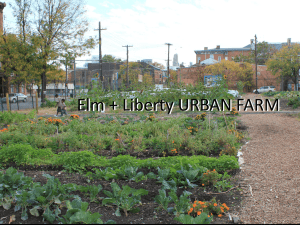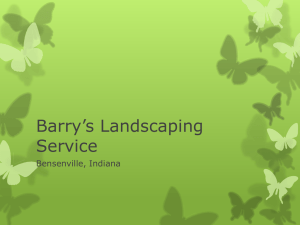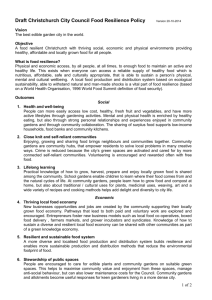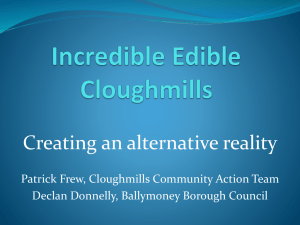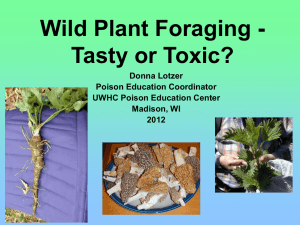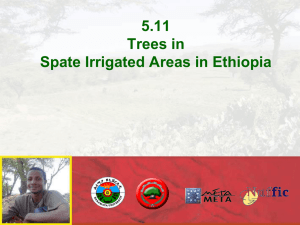enec_395_lit_review
advertisement
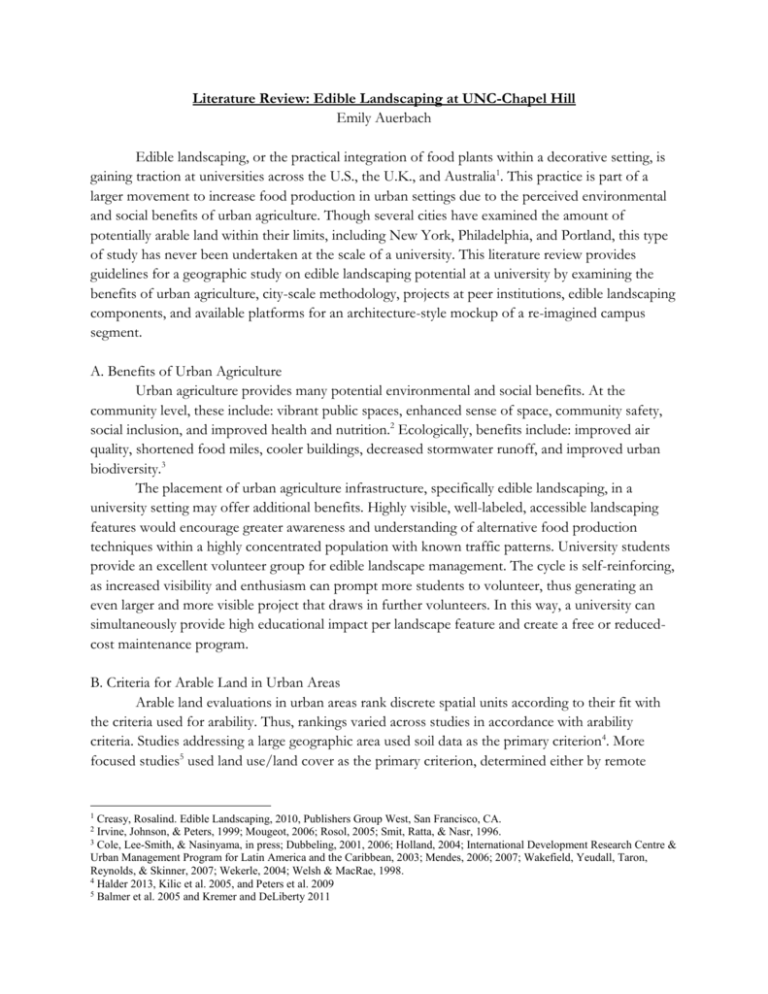
Literature Review: Edible Landscaping at UNC-Chapel Hill Emily Auerbach Edible landscaping, or the practical integration of food plants within a decorative setting, is gaining traction at universities across the U.S., the U.K., and Australia1. This practice is part of a larger movement to increase food production in urban settings due to the perceived environmental and social benefits of urban agriculture. Though several cities have examined the amount of potentially arable land within their limits, including New York, Philadelphia, and Portland, this type of study has never been undertaken at the scale of a university. This literature review provides guidelines for a geographic study on edible landscaping potential at a university by examining the benefits of urban agriculture, city-scale methodology, projects at peer institutions, edible landscaping components, and available platforms for an architecture-style mockup of a re-imagined campus segment. A. Benefits of Urban Agriculture Urban agriculture provides many potential environmental and social benefits. At the community level, these include: vibrant public spaces, enhanced sense of space, community safety, social inclusion, and improved health and nutrition.2 Ecologically, benefits include: improved air quality, shortened food miles, cooler buildings, decreased stormwater runoff, and improved urban biodiversity.3 The placement of urban agriculture infrastructure, specifically edible landscaping, in a university setting may offer additional benefits. Highly visible, well-labeled, accessible landscaping features would encourage greater awareness and understanding of alternative food production techniques within a highly concentrated population with known traffic patterns. University students provide an excellent volunteer group for edible landscape management. The cycle is self-reinforcing, as increased visibility and enthusiasm can prompt more students to volunteer, thus generating an even larger and more visible project that draws in further volunteers. In this way, a university can simultaneously provide high educational impact per landscape feature and create a free or reducedcost maintenance program. B. Criteria for Arable Land in Urban Areas Arable land evaluations in urban areas rank discrete spatial units according to their fit with the criteria used for arability. Thus, rankings varied across studies in accordance with arability criteria. Studies addressing a large geographic area used soil data as the primary criterion4. More focused studies5 used land use/land cover as the primary criterion, determined either by remote 1 Creasy, Rosalind. Edible Landscaping, 2010, Publishers Group West, San Francisco, CA. Irvine, Johnson, & Peters, 1999; Mougeot, 2006; Rosol, 2005; Smit, Ratta, & Nasr, 1996. 3 Cole, Lee-Smith, & Nasinyama, in press; Dubbeling, 2001, 2006; Holland, 2004; International Development Research Centre & Urban Management Program for Latin America and the Caribbean, 2003; Mendes, 2006; 2007; Wakefield, Yeudall, Taron, Reynolds, & Skinner, 2007; Wekerle, 2004; Welsh & MacRae, 1998. 4 Halder 2013, Kilic et al. 2005, and Peters et al. 2009 5 Balmer et al. 2005 and Kremer and DeLiberty 2011 2 sensing or ground truthing. All studies utilized multi-step processes to determine the agricultural suitability rank of a given unit. Given the highly concentrated nature and small land area of the UNC-Chapel Hill campus, an approach similar to that taken by Balmer et al. 2005 in Portland, OR may be appropriate. This team isolated tax parcels under government management, visually reviewed each parcel using aerial photography, and performed site visits to evaluate likely candidates. Table 1 contains the criteria used to evaluate parcels aerially. Parcels that met all relevant criteria could then be classified as a site for potential small scale, large scale, community garden, or impervious surface agriculture. Table 1: Attributes for aerial evaluation from Balmer et al. 20056. C. Projects at Peer Institutions Universities have primarily implemented community plot programs, non-row landscaping, and kitchen gardens. At least twelve universities across the US, the UK, and Australia have already implemented some level of edible landscaping. Each of these projects is managed either by student volunteers or by a facilities or grounds director who took the initiative to begin the project. Though many of the projects are intended to provide produce for on-campus dining halls in the future, all but one were constructed with the expectation that their creation and maintenance would cost more than the cost savings they provided through free produce. The typical project was justified with a 6 Balmer, Kevin; Gill, James; Kaplinger, Heather; Miller, Joe; Peterson, Melissa; Rhoads, Amanda; Rosenbloom, Paul; and Wall, Teak. “The Diggable City: Making Urban Planning a Priority.” 2005. Nohad A. Toulan School of Urban Studies and Planning, for the City of Portland, OR. statement such as “College and university campuses are incredibly important places to demonstrate sustainability practices that our planet and society truly need.”7 Other statements from project leaders include: “Edible landscaping is a very hot trend in home and commercial gardening, and it is great for our department and the UM in general to be actively engaged in it” -Emily Tepe, University of Minnesota Horticulturist “The biggest benefit at a university is the potential to enhance education, to have the physical campus be part of the learning process, not just the space where it happens.” -Tom Hairston, Eastern Mennonite University Grounds Universities with edible landscaping projects include: University of California Davis8, University of Massachusetts Amherst9, Clemson University10, University of Maine11, University of the Sunshine Coast12, University of Minnesota Twin Cities13, Eastern Mennonite University14, Conventry University15, UW-Madison16, Kansas State University17, University of Minnesota Duluth18, and Loughborough University19. D. Structures and Approaches for Edible Landscape Components Projects from UC Davis, UMass Amherst, and Clemson represent the three major types of existing edible landscaping projects at universities. These three types are: a centralized garden operated by the university; dispersed gardens operated by volunteers; and decentralized edible plantings integrated into existing landscape features. 1) UC-Davis: Replaced a 6,000 square-foot courtyard with an educational garden in 2008. The garden is planted with over 100 types of flowers, fruits, and vegetables, managed by a university staff member, and aided by volunteers. The university frequently hosts events in the space, which features clear labelling for all plants and larger signs detailing health benefits or histories for certain plants. All food is donated to students in need. 2) UMass-Amherst: Planted four edible, educational permaculture gardens since 2009. 4,500 pounds of produce harvested to date, with all produce utilized in on-campus dining halls. 7 US Fed News Service, Including US State News. University of Massachusetts Amherst offers “Permaculture Your Campus” conference. 12 June 2013. Washington, D.C. 8 Kim, Gina. The Sacramento Bee. In UC Davis courtyard, environment is edible. 02 Jul 2010. Davis, CA. 9 Lederman, Diane. The Republican. Garden becomes UMass Amherst. 28 Sep 2011. Springfield, MA. 10 Targeted News Service. Clemson University’s landscape becoming edible. 28 Mar 2011. Washington, D.C. 11 Bangor Daily News. Edible forest gardens focus of UMaine event. 01 May 2009. Bangor, Me. 12 Sunshine Coast Daily. Edible garden coming at uni. 03 Apr 2013. Maroochydore, Qld. 13 Palmer, Kim. McClatchy- Tribune Business News. Gardens good enough to eat: The edible landscape trend is transforming lawns and gardens. 12 May 2010. Washington, D.C. 14 Delesline, Nate III. The Virginian-Pilot. Edible gardens are right on campus. 28 Aug 2011. Norfolk, VA. 15 Griffin, Mary. Coventry Telegraph. Salad days at uni: Edible campus scheme leads new trend. 17 Apr 2013. Coventry, UK. 16 Badger Herald. UW Sustainability Committee plans ‘Edible Landscapes.’ 25 Sep 2014. Madison, WI. 17 U.S. Fed News Service, Including US State News. Alternative meal plans: Students study on-campus edible landscapes. 18 Aug 2011. Washington, DC. 18 Targeted News Service. Edible Landscape: Campus Produce is the Root of this Summer’s Grounds Maintenance. 06 Aug 2010. Washington, D.C. 19 Watkins, Amy. Loughborough Echo. ‘Edible landscape’ project scoops award. 07 Mar 2014. Loughborough, UK. Over 2000 fruit trees, berry bushes, herbs, flowers, and vegetables planted across campus. Maintained by students who receive class credit for their work at the gardens. Winner of the White House Campus Champions of Change Challenge in 2012. 3) Clemson University: Planted fig, pomegranate, and blueberry plants outside of a university Cafe in 2011. These plants were integrated into the existing landscaping rather than in a garden. Across all three of these major types, universities employed similar types of edible landscaping features. All universities replaced ornamental trees with fruit trees. Popular devices included replacing shrubs with rosemary, ground cover with strawberries, and arbor plants with grape vines. Additional common edible landscaping plants include: rainbow swiss chard, artichokes, fennel, dill, cilantro, Thai basil, pole beans, lavender, and sage.20 This review will not address the decisionmaking components for determining which plant should replace an existing landscaping element. E. Platforms Available for Mockup Creation SketchUp, a free 3D modeling software, was recommended by a professional local food landscape designer. The software is intended for applications such as architectural, interior design, civil and mechanical engineering, film, and video game design. F. Takeaways for UNC-Chapel Hill 1. Data: Available data includes UNC basemap, UNC tree map, UNC buildings, Chapel Hill and Carrboro streets, aerial imagery, and UNC rooftops. With the addition of irrigation and vegetation data, the proposed methodology will be possible. 2. Potential Methodology: This methodology is subject to change. a. Divide large UNC basemap and all UNC properties into smaller units. Each potential growing space is its own polygon. b. Create a new layer with all steps, curbs, lampposts, outdoor parking spots, etc. (aka all non-mutable built environments). Clip to remove from consideration. c. Pick out all vegetated areas using remote sensing. Cross-reference with vegetation data if possible. If not, use UNC_basemap to clip out all built areas and assume the rest are vegetated. 2 points for all previously vegetated areas. d. For both built and vegetated areas, use tree and building heights from existing datasets along with sun placement to identify shading. Buffer all identified trees and remove buffer from layer to avoid overshading. 2 points for low shade, 1 point for medium shade, 0 points for high shade. e. Create rankings of slope based on Tait’s LIDAR data. Vectorize the raster output so that all pixels with a given slope are joined into a single layer. Intersect with existing units so that each unit is assigned the dominant pixel. Evaluate all units for direction. 2 points for desirable slope, 1 point for medium slope, 0 points for undesirable slope. 20 McConahey, Meg. The Press Democrat. Edible beauty: The good life garden at UC Davis features a landscape that produces sustainable food, but is also pretty enough for parties. 15 Aug 2009. Santa Rosa, CA. f. Buffer the polygons according to proximity of irrigation. Within 10 feet is 2 points, within 20 feet is 1 point, over 20 feet is 0 points. g. Visibility ranking based on observed traffic patterns. 2 points if on main campus, 1 point if on undergraduate grounds, 0 points if office use only. h. Sum the rankings to generate final map. Best use is agriculture for 8-10 points. 4-7 is still reasonably good. 1-3 is possible, but not preferred. 0 is highly unsuitable. 3. Landscaping Features: I propose three major feature types for the UNC-Chapel Hill Campus. The first is low-maintenance, low-footprint landscaping such as the replacement of low-value ornamental trees and clustering of herbs within existing vegetation across campus. All produce would be harvested by the community at large rather than for a specific outlet. This is best suited for high-traffic areas that lack large tracts of available land. The second is individual raised bed plots for rooftops or underutilized parking spots. These plots would be maintained by the individual who signs up for the plot and all vegetation contained therein would belong to the individual. The third is a centralized educational garden maintained by university staff with the aid of volunteers. This garden could function as a sub-section of existing vegetated areas, such as the Arboretum or the Botanical Garden. All produce could be used in dining halls, donated, or harvested by the community at large. References Badger Herald. UW Sustainability Committee plans ‘Edible Landscapes.’ 25 Sep 2014. Madison, WI. Balmer, Kevin; Gill, James; Kaplinger, Heather; Miller, Joe; Peterson, Melissa; Rhoads, Amanda; Rosenbloom, Paul; and Wall, Teak. “The Diggable City: Making Urban Planning a Priority.” 2005. Nohad A. Toulan School of Urban Studies and Planning, for the City of Portland, OR. Bangor Daily News. Edible forest gardens focus of UMaine event. 01 May 2009. Bangor, Me. Cole, D. C., Lee-Smith, D. and Nasinyama, G. in press. Urban food production and public health: Generating evidence to guide policy., Kampala: Lima and Makerere University Press. Creasy, Rosalind. Edible Landscaping, 2010, Publishers Group West, San Francisco, CA. Delesline, Nate III. The Virginian-Pilot. Edible gardens are right on campus. 28 Aug 2011. Norfolk, VA. Dubbeling, M. (2001). A framework for facilitating planning and policy. Urban Agriculture Magazine, 5, Topic Paper 2. Retrieved November 3, 2004, from http://www.ruaf.org/newslgen_fr.html Dubbeling, M. (2006, June). Optimizing use of vacant space for urban agriculture through participatory planning processes: A strategy to strengthen urban food security and municipal participatory governance. Paper presented at the First Preparatory Workshop for World Urban Forum 2006, Toronto, ON, Canada. Griffin, Mary. Coventry Telegraph. Salad days at uni: Edible campus scheme leads new trend. 17 Apr 2013. Coventry, UK.Halder, Jadab Chandra. “Land suitability assessment for crop cultivation by using remote sensing and GIS.” 2013. Journal of Geography and Geology 5:3, 6574.Holland, L. 2004. Diversity and connections in community gardens: A contribution to local sustainability.. Local Environment, 9(3): 285–305. International Development Research Centre & Urban Management Program for Latin America and the Caribbean. (2003). Guidelines for unicipal policymaking on urban agriculture. Irvine, S., Johnson, L. and Peters, K. 1999. Community gardens and sustainable land use planning: A case-study of the Alex Wilson Community Garden.. Local Environment, 4(1): 33–46. Kilic, Seref; Evrendilek, Fatih; Senol, Suat; and Celik, Ismail. “Developing a suitability index for land uses and agricultural land covers: A case study in Turkey.” 2005. Environmental Monitoring and Assessment 102.1:3, 323-335. Kim, Gina. The Sacramento Bee. In UC Davis courtyard, environment is edible. 02 Jul 2010. Davis, CA. Kremer, Peleg; and DeLiberty, Tracy L. “Local food practices and growing potential: Mapping the case of Philadelphia.” 2011. Applied Geography 31:4, 1252-1261. Lederman, Diane. The Republican. Garden becomes UMass Amherst. 28 Sep 2011. Springfield, MA. McConahey, Meg. The Press Democrat. Edible beauty: The good life garden at UC Davis features a landscape that produces sustainable food, but is also pretty enough for parties. 15 Aug 2009. Santa Rosa, CA. Mendes, W. (2006). Creating a 'just and sustainable' food system in the city of Vancouver: The role of governance, partnerships and policymaking. Simon Fraser University, Burnaby, Canada. Department of Geography. Unpublished doctoral thesis. Mendes, W. 2007. Negotiating a place for “sustainability” policies in municipal planning and governance: The role of scalar discourses and practices.. Space & Polity, 11(1): 95– 119.Mougeot, L. 2006. Growing better cities: Urban agriculture for sustainable development., Ottawa, ON, , Canada: International Development Research Centre. Palmer, Kim. McClatchy- Tribune Business News. Gardens good enough to eat: The edible landscape trend is transforming lawns and gardens. 12 May 2010. Washington, D.C. Peters, Christian J; Bills, Nelson L; Lembo, Arthur J; Wilkins, Jennifer L; and Fick, Gary W. “Mapping potential foodshed in New York State: A spatial model for evaluating the capacity to localize food production.” 2009. Renewable Agriculture and Food Systems 24:1, 72-84. Rosol, M. 2005. Community gardens—A potential for stagnating and shrinking cities? Examples from Berlin.. Erde, 136(2): 165–178. Smit, J., Ratta, A. and Nasr, J. 1996. Urban agriculture: Food, jobs and sustainable cities., New York: United Nations Development Programme. Sunshine Coast Daily. Edible garden coming at uni. 03 Apr 2013. Maroochydore, Qld. Targeted News Service. Clemson University’s landscape becoming edible. 28 Mar 2011. Washington, D.C. Targeted News Service. Edible Landscape: Campus Produce is the Root of this Summer’s Grounds Maintenance. 06 Aug 2010. Washington, D.C. U.S. Fed News Service, Including US State News. Alternative meal plans: Students study on-campus edible landscapes. 18 Aug 2011. Washington, DC. US Fed News Service, Including US State News. University of Massachusetts Amherst offers “Permaculture Your Campus” conference. 12 June 2013. Washington, D.C. Wakefield, S., Yeudall, F., Taron, C., Reynolds, J. and Skinner, A. 2007. Growing urban health: Community gardening in South-East Toronto.. Health Promotion International, 22(2): 92–101. Watkins, Amy. Loughborough Echo. ‘Edible landscape’ project scoops award. 07 Mar 2014. Loughborough, UK. Wekerle, G. R. 2004. Food justice movements: Policy, planning, and networks.. Journal of Planning Education and Research, 23(4): 378–386. Welsh, J. and MacRae, R. 1998. Food citizenship and community food security: Lessons from Toronto, ON, Canada.. Canadian Journal of Development Studies, 19: 237–255.
